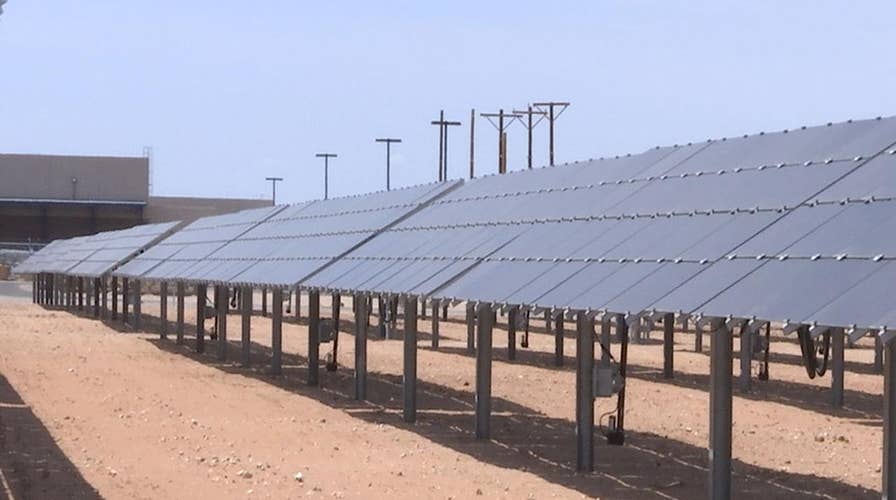Texas bets big on solar energy as massive grid powers up
El Paso Electric brought their new community solar facility online, the biggest in Texas
California’s rush to impose harsh government mandates cutting carbon dioxide emissions in the generation of electricity is raising the electricity bills of families and businesses across the state. Poor families are suffering the most.
In sharp contrast, Texas is successfully taking a free-market approach that is increasing the use of clean renewable energy and lowering electricity bills in the state.
The tale of two states offers a lesson for the nation.
The far-left Democrats who control state government in California have doubled down on their extremist campaign to cut carbon dioxide emissions – regardless of the cost and the pain they inflict on Californians, who are already struggling to pay some of the highest electricity bills in the nation.
California’s Democratic Gov. Jerry Brown said in September: “De-carbonizing the economy when the economy depends so totally on carbon is not child’s play. It’s quite daunting.”
“Daunting” is an understatement. After decades of severe state mandates and skyrocketing subsidies for renewable energy, Brown boasted that California gets about 30 percent of its energy from renewable sources – with a goal of 50 percent in seven years.
That may sound impressive, but Brown’s numbers referred only to electricity generation. He didn’t count transportation – the cars, trucks, buses, motorcycles, trains and planes that carry millions of Californians every day. Transportation accounts for about 39 percent of the Golden State’s energy consumption – and is almost all powered by carbon-based gasoline, diesel and jet fuel.
In 2004, at the dawn of California’s accelerated push into “de-carbonizing,” 10 percent of the state’s power came from approved renewable sources, with the total rising to 25 percent when electricity from large hydroelectric dams was included.
By 2016, California’s electric grid derived 25 percent of its power from renewable energy sources, with another 10 percent coming from large hydroelectric dams. While the dams also generate renewable electricity, they are loathed by environmentalists, so they don’t count towards California’s non-carbon energy goals.
Pushing California’s electric portfolio from 25 percent renewables, including hydroelectric dams above 50 megawatts, to 35 percent over a dozen years is a direct consequence of several laws and regulations intended to increase mostly wind and solar power generation.
Interestingly, in the first three months of this year, 23 percent of the electricity in Texas’ power grid came from wind generation. And while federal subsidies play a role in both states, Texas’ policy towards electric generation is decidedly more market-based than in California.
In addition to heavy government intervention in California’s electricity market, its big publicly regulated utilities are guaranteed a rate of return by the state government from both the electricity they sell to the public and from the new generation facilities – such as natural gas power plants, wind turbines and solar thermal facilities – that they build.
This means that no matter how much a new generating facility costs and no matter how much the electricity costs produced by the facility, the utility will make a profit as guaranteed by law. Crony corporatism is a great racket – if you can get into it.
But Texas guarantees no profits to the firms that build and operate power plants there.
The difference can readily be seen in the electrical rates in each state.
In August of 2004 and the 12 months prior, before California started its big push into renewable energy, monthly retail electricity rates averaged 50 percent higher than the U.S. average. Rates in Texas during the same period meanwhile stood at 2 percent above the national average.
Texas was at the time in the middle of a multiyear electric market deregulation effort. The effort was heavily criticized by so-called consumer protection advocates as a giveaway to big business.
This year –13 years later – it’s instructive to see how our nation’s two most-populous states have diverged in terms of the results of their energy policies.
California’s average retail electric rates in the most recent 12 months ending in August this year were again 50 percent higher than the national average – in spite of politicians’ promises that renewable energy would be less expensive. In the just the past seven years, California’s retail electricity prices have shot up 20 percent.
Texas consumers, on the other hand, went from paying more than the national average to paying electricity prices 19 percent lower than the national average.
Looking at it another way, in 2004 Californians paid 47 percent more for their electricity than Texans. By 2017 Californians paid almost double – 86 percent more – to keep the lights on and run manufacturing than did Texans.
The bottom line for California’s households isn’t pretty. Last year, California shelled out $35.6 billion for electricity. In inflation-adjusted dollars, Californians were paying 8.3 percent more for their power in the 12 months ending in August 2017 compared to 13 years earlier.
This amounts to what is effectively a de-carbonization and regulatory tax of $3 billion a year, or $299 for a family of four on a per capita basis.
In Texas, where market competition has helped drive down the price of electricity, consumers are saving about $4.7 billion a year – or $669 per family of four compared to electric prices 13 years ago in inflation-adjusted terms.
Data suggests that, if California followed Texas’ market-based electric policy, the per capita savings could be more than $242 per year – even with a robust increase in renewable energy.
As almost always happens, Big Government mandates raise prices for families and businesses. The private sector lowers them.

